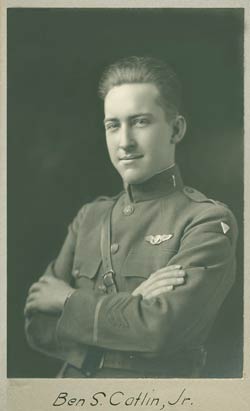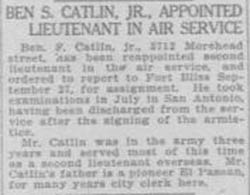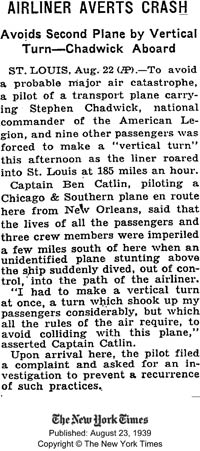|
Most of the information on this page comes to us from Ben S. Catlin's grandson and namesake (cited, right sidebar). Mr. Catlin qualifies his information by stating, "Almost all of my information is unsubstantiated, but I will pass it on to you in hopes you find it interesting." And, "
Families have a way of embellishing the accomplishments of family members and I suspect our family is no exception."
That said, we actually do have a little more documented information. Although there is no biographical file (left sidebar) at the Smithsonian for him, there is some information available for pilot Catlin online, and in a variety of books. What is available points toward an accomplished pilot with hard-earned experience. Catlin was an El Paso, TX native; his father arrived there as an early pioneer during the 19th century.
Ben S. Catlin, Ca. WWI (Source: El Paso, TX Public Library)
 |
One thing we know for certain is that Catlin passed through Tucson at least once, on Thursday, April 4, 1929. He arrived solo in the Travel Air he identified as NC3947. He signed the Register at 12:25PM, remained on the ground a few hours and departed for Phoenix, AZ at 4:15PM. Notably, his airplane still exists. The 1928 Travel Air 3000, S/N 321, is owned by the Historic Aircraft Restoration Museum in Ellsinore, MO.
Photo, right, is by the photographer Fred J. Feldman nicely digitized and made available to us online by the El Paso Public Library. He wears his pilot wings.
Catlin learned to fly in the military. He received his wings in 1914 in a trainer with no ailerons. He told his grandson, you "bent the wing spars" to make the airplane turn. He probably learned in an early Wright Flyer that used wing warping for initiating and controlling turns.
El Paso Herald, September 18-19, 1920 (Source: Web)
 |
Above, news from the El Paso Herald weekender of September, 18-19, 1920 cites his service in the Army as mostly "overseas." He flew in World War I as a bomber pilot in the deHavilland DH-4 and saw a lot of combat. Upon return to the U.S., he flew at Crissy Field in San Francisco, CA. And he flew forest fire patrol out of Mather Field. He left the service but was reinstated and ordered to San Antonio, TX during September, 1920 as cited in the article.
The New York Times, June 6, 1933 (Source: NYT)
 |
It was in San Francisco where he met the present Ben Catlin's grandmother at a dance. She was Mildred Lydia Olsen and she was from Sacramento, CA. Mr. Catlin states, "They married and my father was born in San Francisco in about 1921."
When he left the service the second time, he opened a small flying school near the site of the present Santa Anita Racetrack. Catlin is credited with teaching Register pilot Pancho Barnes how to fly there. This is documented in this REFERENCE, pp. 55ff. This book provides some insight into Catlin's military service and personality. The author states, "Catlin was known to be a fair instructor with a penchant for flying gear acquired as a member of the Lafayette Escadrille, an American expeditionary force trained in France with French equipment during WWI. He always wore his familiar leather jacket, whipcord pants, and a pair of shiny boots. He would have worn his flying helmet and goggles on the ground but compromised by carrying them." According to the reference, the airplane they used for training was the Register Travel Air NC6019. He allowed Barnes to fly solo on September 6, 1928.
Family lore has it that Catlin, "Helped to design the 'Winnie Mae.'" And "Helped to design some of the early aviation procedures such as 'needle ball and airspeed' and instrument procedures...." I could find no sources that discussed these.
Lore also states that Catlin, "Was the FBO operator at either Glendale or Pasadena." According to this REFERENCE, page 65, Catlin was the airport manager, during at least 1928-29, at the Carpenteria Airport. It was at Carpenteria that Pancho Barnes again sought Catlin out to instruct her for her Transport license, which she acquired on February 22,1929. She was the sixth woman in the U.S. to earn one.
About the same time, family lore suggests he, " Flew for William Randolph Hearst bringing 'the dailies' and other essentials up from LA to the castle." And he, " Flew for Howard Hughes. He normally ferried the racers from the factory and later flew in the movie 'Hell's Angels.' He earned $100 per week while flying in 'Hell's Angels.'" I could find no sources that documented his work with Hearst or Hughes. If Catlin flew for the early motion pictures, chances are good he would be mentioned in this REFERENCE. He is not. Other Register pilots, however, are known to have flown stunt scenes for the premier Golden Age movies. See, for example, Dick Rinaldi, Clarence "Ace" Bragunier, Tex Rankin, Paul Richter and Art Goebel.
There is circumstantial evidence that Catlin may have visited Tucson at least a second time on June 5 or 6, 1933. The article, right, from The New York Times of June 6, 1933 reports on a visit to Tucson by Mrs. Roosevelt. Unfortunately, the article does not mention the pilot or the type of aircraft Mrs. Roosevelt traveled in. It appears that Catlin brought President and Mrs. Roosevelt's son, Elliott, to Douglas, AZ to meet his mother.
As background, during the late 1930s, Catlin flew for Chicago & Southern Air Lines and continued with Delta Airlines after they bought Chicago & Southern in 1953. He was the senior pilot for Delta for almost 10 years. He lived in Picayune, MS on a farm and flew primarily between New Orleans, Havana, Cuba, Jamaica and Caracas, Venezuela. He was fluent in Spanish.
With that background, also circumstantial is a derivation of the connection between Roosevelt and Catlin. Pacific Seaboard Air Lines was the parent company of Chicago & Southern and operated a route up and down the Pacific coast of California about this time. This could be the referent for the "Coast airlines company" that Elliott was "managing," although I could find no documentation that he was ever in that line of work. Nor could I find any mention that Catlin flew for Pacific Seaboard. But it would make sense if he did and then continued with Chicago & Southern after the transition. Roosevelt did work for Hearst, however, in the communications department managing Hearst's radio chain. Regardless, Elliott and Catlin are reported in the article to offer rides to visitors at Douglas. It is not clear if either Elliott or Catlin, or both, accompanied Mrs. Roosevelt north from Douglas through Tucson and Phoenix before going to Los Angeles.
The New York Times, August 23, 1939 (Source: NYT)
 |
Further, it's natural to examine for a VIP arrival the details of the Register around the first week of June, 1933 (page 200). Sadly, the examination reveals nothing. There is actually an unusual hiatus in the Register from May 17 to June 20, 1933. No pilots or aircraft are signed in the Register between those dates. So it is not possible from the Register to deduce with whom and in what aircraft the President's wife might have been flying. By the way, "Ma" Ferguson was the first female governor of Texas (Democrat) who replaced her husband who lost the governorship through impeachment.
Another interesting finding in this article is the mention of Mrs. John C. (Isabella Selmes) Greenway. She was not a stranger to the Register. Having recently lost her husband, she formed a company with Register pilot C.W. "Bill" Gilpin. They went into the passenger business
under the name Gilpin and Greenway Airlines
Company, Inc., or G&G Airlines. "Gilpin",
as the line was called, grew into one of the largest fixed
base companies in the southwest. G&G flew between Los
Angeles and Tijuana, carrying "parched" Californians
to the tracks and gambling casinos in Mexico (remember,
Prohibition was still the law of the land until December,
1933). Besides being a friend of the Roosevelts, Mrs. Greenway later became a member of the U.S. House of Representatives and built the Arizona Inn at Tucson.
The New York Times of August 23, 1939, left, reported an incident that "shook up" ten Chicago & Southern passengers, but avoided a tragic mid-air collision. The steep turn was clearly justified. It is not clear what airplane he was flying. Chicago & Southern flew Bellanca CH-300s, which have only six seats, and they didn't acquire their first DC-3 until 1940. Neither do I have information on the health of the passengers or the fate of Catlin's filed complaint.
Other family lore that I cannot document is that he, "Lived on church handouts for a while while he struggled making money 'flying for a living.'" And that he, "Apparently took Howard Hughes' flight license away on a dare." Likewise, I have no information about whether or how he helped with some of the early organizing of the transport pilots unions.
Or that he "Flew the mail for a while." And, "Crashed several times while ferrying the mail." However, Chicago & Southern did have an airmail route (#8), which was acquired in 1934. If Catlin was flying for Chicago & Southern during 1934 and beyond, then he carried the mail.
He retired (date?) with 36,000 hours of flight time when the FAA passed the rule that pilots could not fly after age 60. I do not know his birth or death dates. If you can corroborate or illuminate any of the above, please let me KNOW.
---o0o---
THIS PAGE UPLOADED: REVISED:
|





